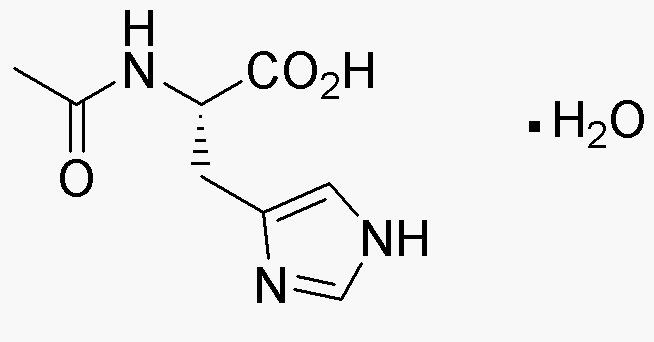Na-Acetyl-L-Histidine·H2O is widely utilized in research focused on:
- Biochemical Research: This compound serves as a valuable substrate in studies of enzyme activity, particularly in the context of histidine metabolism and its role in protein synthesis.
- Nutraceuticals: It is incorporated into dietary supplements aimed at enhancing cognitive function and reducing fatigue, due to its potential neuroprotective properties.
- Pharmaceutical Development: Researchers explore its effects in drug formulation, particularly in developing treatments for conditions related to oxidative stress and inflammation.
- Cell Culture Studies: Used as a supplement in cell culture media to promote cell growth and viability, especially in studies involving neuronal cells.
- Antioxidant Research: Investigated for its potential as an antioxidant, contributing to the development of products aimed at combating oxidative damage in various biological systems.
Informations générales
Propriétés
Sécurité et réglementation
Applications
Na-Acetyl-L-Histidine·H2O is widely utilized in research focused on:
- Biochemical Research: This compound serves as a valuable substrate in studies of enzyme activity, particularly in the context of histidine metabolism and its role in protein synthesis.
- Nutraceuticals: It is incorporated into dietary supplements aimed at enhancing cognitive function and reducing fatigue, due to its potential neuroprotective properties.
- Pharmaceutical Development: Researchers explore its effects in drug formulation, particularly in developing treatments for conditions related to oxidative stress and inflammation.
- Cell Culture Studies: Used as a supplement in cell culture media to promote cell growth and viability, especially in studies involving neuronal cells.
- Antioxidant Research: Investigated for its potential as an antioxidant, contributing to the development of products aimed at combating oxidative damage in various biological systems.
Documents
Fiches de données de sécurité (FDS)
La FDS fournit des informations de sécurité complètes sur la manipulation, le stockage et l’élimination du produit.
Spécifications du produit (PS)
Le PS fournit une description complète des propriétés du produit, notamment sa composition chimique, son état physique, sa pureté et les exigences de stockage. Il détaille également les plages de qualité acceptables et les applications prévues du produit.
Certificats d'analyse (COA)
Recherchez des certificats d'analyse (COA) en saisissant le numéro de lot du produit. Les numéros de lot et de lot se trouvent sur l'étiquette d'un produit, après les mots « Lot » ou « Lot de fabrication ».
Numéro de catalogue
Numéro de lot/série
Certificats d'origine (COO)
Ce certificat d'exploitation confirme le pays dans lequel le produit a été fabriqué, et détaille également les matériaux et composants utilisés et s'il est issu de sources naturelles, synthétiques ou autres sources spécifiques. Ce certificat peut être requis pour les douanes, le commerce et la conformité réglementaire.
Numéro de catalogue
Numéro de lot/série
Fiches de données de sécurité (FDS)
La FDS fournit des informations de sécurité complètes sur la manipulation, le stockage et l’élimination du produit.
DownloadSpécifications du produit (PS)
Le PS fournit une description complète des propriétés du produit, notamment sa composition chimique, son état physique, sa pureté et les exigences de stockage. Il détaille également les plages de qualité acceptables et les applications prévues du produit.
DownloadCertificats d'analyse (COA)
Recherchez des certificats d'analyse (COA) en saisissant le numéro de lot du produit. Les numéros de lot et de lot se trouvent sur l'étiquette d'un produit, après les mots « Lot » ou « Lot de fabrication ».
Numéro de catalogue
Numéro de lot/série
Certificats d'origine (COO)
Ce certificat d'exploitation confirme le pays dans lequel le produit a été fabriqué, et détaille également les matériaux et composants utilisés et s'il est issu de sources naturelles, synthétiques ou autres sources spécifiques. Ce certificat peut être requis pour les douanes, le commerce et la conformité réglementaire.


